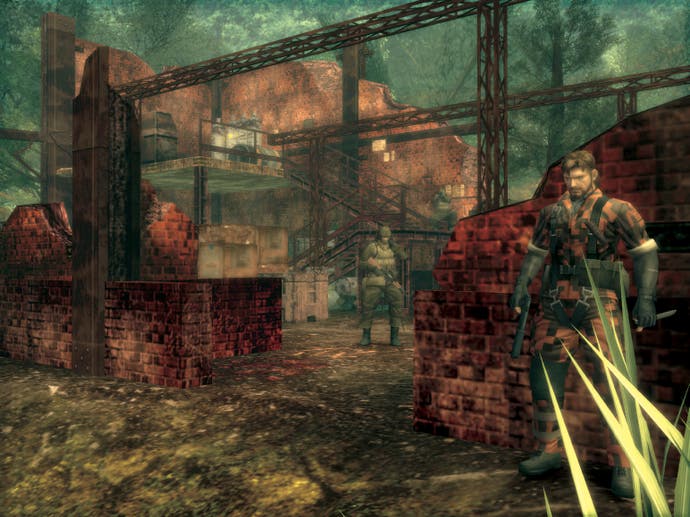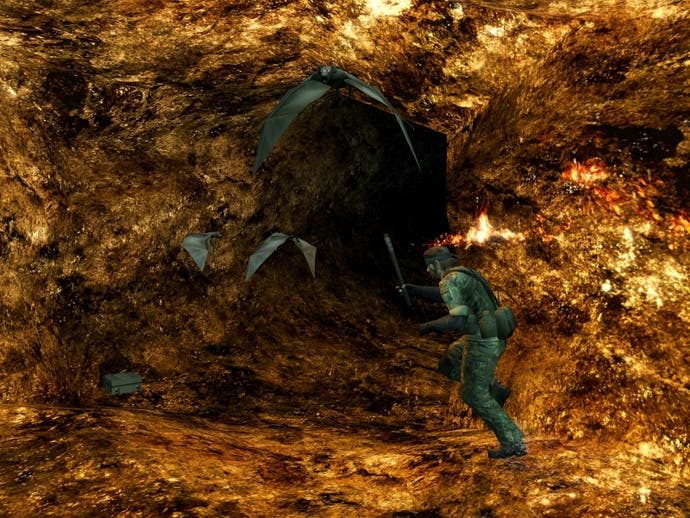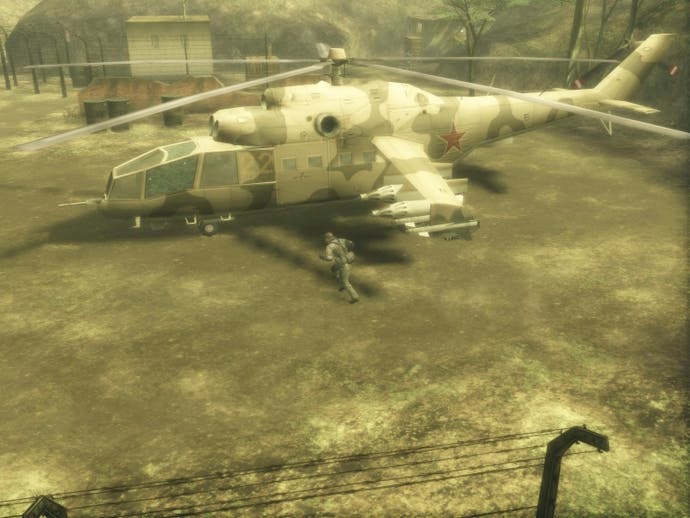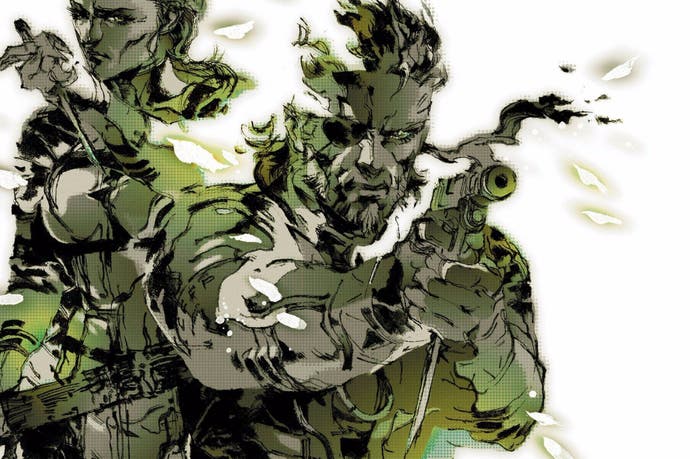Metal Gear Solid 3: From Russia with love
“You're pretty good.”
Metal Gear Solid 2 ended with an explosion of questions. In creating a game that questioned its own status as a game, Kojima had opened countless essentially insoluble plot threads. The most pressing one was: what next? Hideo Kojima initially tried to avoid directing Metal Gear Solid 3, or so the talk goes. He did not.
One of Metal Gear Solid 2: Sons of Liberty's core messages was the idea of selecting what philosophy we pass on to the next generation, which can be read literally as a desire to pass on the torch. Kojima's unease at creating Metal Gear Solid 2, which he envisioned as a repeat, was another central theme. And despite Sons of Liberty's quality it met a divisive reception - with many of the most extreme reactions venomous, particularly towards Raiden. Perhaps it had even gone too far with its themes and their in-game manifestations, which had bewildered many but left others unironically baying for more.
In such circumstances, who can blame Kojima for imagining a sequel where all the baggage accumulated over two MSX games, two Metal Gear Solid games, and far too many obsessive fans simply didn't matter. So Metal Gear Solid 3: Snake Eater was born, a game that takes the series timeline back by half a century, and for good measure doesn't feature either a Metal Gear or Solid Snake. The perfect yin to the high-falutin' yang of Sons of Liberty, in the mind of this particular movie buff, was a period thriller.
Snake Eater roots itself in a year, 1964, and the era of the Cold War. The Cuban Missile Crisis of 1962 is referenced as the political background to the game's events, while conversations between President Johnson and Khrushchev are fictionalised alongside them. The player is cast as the US soldier Naked Snake who, in an unforgettable opening cutscene, executes a 'halo jump' from the atmosphere into Russia.

This might sound like heavy going but, from the gloriously OTT Bond tribute of Harry Gregson-Williams' opening theme, Snake Eater's vibe is unmistakeably 60s spy thriller. The period setting permeates everything from the monochrome green menus to the cast - with a posh British commander, a fruity support agent or two, some evil Russians, and a heroic yank-next-door called John at the centre of it all. Naked Snake's codec equivalent is a radio, and his gadgets are a step back too: the Soliton radar of its predecessors basically reveal everything, but Snake Eater's circular radar has a line doing lazy 360 sweeps to show blinking dots. It's a different era.
Simplifying the future-tech loadout of Metal Gear Solid was the first step in making a new kind of stealth game. One of the reasons Metal Gear Solid is so interesting as a series, rather than the individual games, is how it has dealt with being sequelised - the vast majority of so-called AAA series are built on iteration and repetition only, with words like innovation used for new weapons. Only Metal Gear Solid reinvents the game's systems around new principles each time, and hence Snake Eater's jungle.
The brilliance of Snake Eater going back in time is that it goes hand-in-hand with an enormous increase in complexity for the game's systems - Metal Gear Solid 3 is a decisive break from the arcade style of Metal Gear Solid, and almost simulation in feel. The visuals are no longer clean edges and chrome textures but messier, natural hues that hide player and guards alike. Enemies can see much further than ever before, to almost realistic distances, and are sensitive to sudden movements or sounds in their vicinity. They're curious. They call in things. And when everything kicks off, they work together.
Against this Naked Snake has a profound relationship with the environment, to the extent he's almost an extension of it. Snake Eater has countless environmental objects but the most crucial is tall grass. Here Snake can stay on his belly in first-person and, provided he's wearing good camo and doesn't move, isn't going to be spotted. Shuffling through, watching guards patrol, sneaking across gaps, and pouncing from cover is a new type of thrill.
Though still a linear game, Snake Eater largely abandons the compact, geometrical arenas of Metal Gear Solid 1&2 in favour of more open spaces. The previous games had given players many ways to accomplish their goals, but Snake Eater creates something that feels much more like freedom of approach. Alongside this the game tries to craft a predatory mindset in the player, and bring the Snake theme to life. You blend into the environment, slither through grass in first-person, enfold enemies in close quarters, and literally prey on the wildlife. This connection is not a minor thing: Snake Eater is an incredibly tense and exciting experience, and yet you spend a lot of it lying down.

Close-Quarters Combat (CQC) is the new ability that crowns this predator theme. In the previous games an alert enemy in close proximity was always a problem - requiring either clumsy melee attacks or panicked unloading. Even an unaware enemy could only be held up from behind or headshotted. CQC utterly changes this dynamic, allowing Snake to grab any nearby enemy and either KO them with a slam or choke them - from which position they can be interrogated, executed, knocked out, or used as a human shield against their comrades.
Something not many people remember is that the PlayStation 2's controllers featured analogue buttons, because this aspect of Snake Eater was the only time they made sense. After grabbing a soldier with the circle button you would depress it further to hold the knife to his throat and interrogate. At this point he'd begin struggling and the pad would vibrate. You had to keep the circle button depressed just right while he struggled and, if you pushed it all the way, Snake slit his throat. Difficult enough in secret, but now imagine doing it while holding off his comrades. I never meant to cut throats but, in the tension, sometimes I did. It's a great pity that this exquisite touch is completely lost in subsequent Metal Gear Solid games, where no analogue buttons mean CQC becomes a binary technique.
Russia's surprisingly tropical jungle has hiding places everywhere: grass, trees, uneven ridges, overhangs, hills, boulders, swamps, and various small buildings. What really knits this topography and Snake's skills together is a new guard vision model that's so precise you never feel cheated: even a divot that takes you below their eyeline can be enough. Their vision is so nuanced that not only are many locations built around windows and see-through fences, but certain sheds have a missing plank in the wall - through which you can spy, and be spotted.
Alert phases in Snake Eater are much, much longer than in the previous games. Snake is more capable than ever before, but most of the time it's better to just run - and the long, drawn-out Caution phase is both punishment and reward. The former because there are more guards looking for you, the latter because of the delicious music which echoes the 1960s Mission Impossible theme, and the sheer thrill of five guards rushing past your grassy patch.
This all adds up to the most methodical pace of any game in the Metal Gear Solid series, a slow-burner that has the confidence to stick with it. A big part of why Snake Eater pulls this off is the ecosystem: the jungle isn't home to just guards, but to an enormous number of animals. The player is even plugged into this, because Snake has to hunt and eat to keep the new stamina bar high: rats, frogs, bats, crabs, alligators, snakes, rabbits, deer, bees' nests and countless other delicacies await, but it's their omnipresence through Snake's travels that creates the sense of a living, breathing place. Alligators lazily lift their jaws at the water's edge, grass shivers as snakes slide through it, and bushes shake as birds burst away. Even the guard chatter is accentuated by the frog chorus.

Such an increase in sophistication tallied with a desire on Kojima's part to tell a simpler story, one harking back to the 60s thrillers he so clearly adores. Solid Snake, the Metal Gear Solid icon to this point, was something of a finished article - a battle-hardened soldier who takes down Metal Gears for breakfast. But Naked Snake is unproven.
This Snake's a younger character, credulous at points, and still in bed with the US military. If that wasn't enough to set Naked apart from Solid, he's also outclassed. Snake Eater focuses on the student / master dynamic between Naked Snake and the Boss, an antagonist presented both as the "mother of America's special forces" and a traitor to the US. The Boss is an awesome presence from the start, meeting Snake twice and dismantling him each time. Taking her on is presented as hopeless. Yet Snake's persistence, and the Cobra unit's zeal to face her 'disciple', suggest another story.
One that we'll return to, but Snake Eater zips along in comparison to its predecessors because of the spy movie outline - the Boss is a focal point, but much of her character is established by how she keeps the more maniacal villains in line. Electric psycho Volgin gets his jollies by launching nukes and battering people, for example, but when he goes too far in front of the Boss she flattens him in an instant.
So too does she rein in the cocky young Ocelot, and across several scenes functions as the sane and dominant presence. Sadly few of these character-building touches are to be found in the Cobra unit, the Boss's battlefield comrades from World War II. Like Sons of Liberty's Dead Cell these mercenaries are really no more fleshed-out than powers and symbolism, even if they mostly deliver where it matters.
The game's first boss battle, a duel against Ocelot, is reasonable and straightforward enough - with bonus points for Ocelot's daft infatuation with reloading. The Pain is a forgettably-contrived follow-up, a guy covered in hornets who fights you in an environment perfect for killing guys covered in hornets. Thankfully from here the Cobra unit step it up: the encounter with the Predator-inspired Fear is foreshadowed when you pass through the boss arena, littered with traps, before heading to a lab. On your return journey the Fear, and his prehensile tongue, are waiting. It is a hit-or-miss experience and, in this, utterly true to the boss character: panic about this invisible goblin zipping through the trees with his poison darts, and you'll get skewered from multiple directions. Keep a cool head, counter his gear, stand your ground, and it's an easy win.
The greatest Cobra boss is the End. The End is a sniper and the battle takes place across three large maps, around which he and the player can move freely. The hide-and-seek nature of this is an inversion of typical boss fights, but it's the options the player has that makes it. For some the sheer purity is the magic - a long sniper war that can take hours, scanning the horizon, looking for a telltale shuffle. I have been this gentleman sniper but, on a recent runthrough, did what I thought the younger soldier would do - and ran the End down.
After finding the End for the first time I shot him, after which he throws a stun grenade and takes off at speed - but such is the integrity of Snake Eater's systems that you can position Snake to avoid the grenade's flash, see which way he goes, and sprint after. Follow the End enough and, despite his spritely pace, the old boy has to stop for breath. Plug him a few times, and on we go. The End tried faking me out with swerves, setting up ambushes, and even briefly wriggled free once or twice. But I was relentless, and soon beat him down.
This felt cheap, but also a perfectly reasonable way to approach a battle with the world's greatest sniper - the fact Snake Eater allows it is what matters. The openness of this fight, and the uncompromising challenge it presents, are topped off by a few of Kojima's tricks - earlier in the game you can see the End from a distance, hinted at by the fleeting appearance of his health bar. If you've got a sniper rifle, one headshot 'skips' the boss battle. During the fight you can save, wait a week, and the End dies of old age. Or why not show off what a true camo master you are by sneaking up on the End three times, holding him up, and making off with his clothes.
There is so much more. The Sorrow is a boss that forces Snake to wade past every enemy he's killed in the game, a jarring scenario and another brilliant inversion. The many languid stretches of pure stealth between objectives, the infiltration of Groznyj Grad, Raiden's cameo as a Russian officer, and - after a whole game resisting set-piece temptation - a genuinely spectacular chase near the end. MGS3 is simply packed.

But sheer quality is only one part of why Snake Eater is special. Its theme is oft-written as the godawful 'scene,' for no other reason than that it rhymes with gene (the first Metal Gear Solid) and meme (Sons of Liberty). This is a pity because it obscures that in Snake Eater Kojima finally found a human angle for his big ideas. We can all understand genes, and the theory of memes, but it's not so easy to relate to these concepts. But the idea of circumstances forcing your hand, which is what Snake Eater boils down to, is something everyone understands.
Snake Eater's trappings are that of a spy film but the frame is politics, and the leading characters can only play their part. Over the course of the game it becomes clear that Snake and the Boss are locked on a collision course from which only one will walk away - and that neither necessarily wishes this. But the escalating tensions between the US and Russia demand the Boss's head in exchange for world peace, and Snake's role allows no discretion.
While this is a great enough setup for the Metal Gear origin story, Kojima gives this master / student tale its own distinct edge. Metal Gear, after all, was about Solid Snake killing his father. And so Snake Eater's original sin is matricide. The Boss is not just a motherly figure for Snake but, given how he instantly recalls the number of days and years since they last spoke, you sense she's the only kind of family he had.
The final battle is a masterpiece of symmetry, with both characters' movesets echoing each other, set in a circular sea of white lilies. There is no music but gunfire. At the end of the battle the Boss lies defeated, and Snake has to finish his mission by delivering a shot to the head. And the game waits for you to pull the trigger.
You could give any number of reasons as to why killing the Boss has such an impact, but the only important one is complicity. By forcing the player to take that final shot, even when there is no other choice, the question of 'what if' permanently remains. The lily traditionally symbolises innocence or purity and, in a rather heavy-handed but visually stunning moment, the flowers around the Boss's corpse are turned red, before the effect expands over the whole field and the camera zooms up. Naked Snake kills his mentor, and walks glassy-eyed through his country's congratulations - even doing his best to avoid shaking President Johnson's hand.
Every Metal Gear character is being manipulated by bigger forces, but Snake Eater's backdrop is somehow the most inhuman of all. The Boss is a hero of WWII, when the Americans and Russians fought together, and now she is crushed between them in the Cold War to save face for Khrushchev. She sacrificed everything for America, and America sacrificed her anyway.
And Snake? Now we know he's Big Boss, and why he's called that, and why he hates it. Don't be fooled by the period setting or the spy trappings. No matter how much the player hesitates, eventually that final shot will hit home. The greater good wins out, the Boss dies, and a terrorist is born. Boom.

